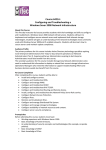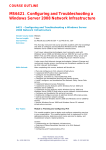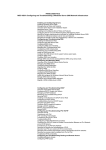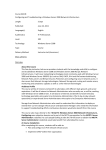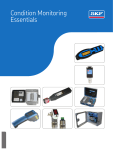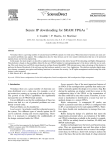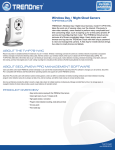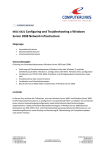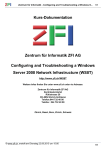Download Corso: Configuring and Troubleshooting a Windows Server 2008
Transcript
Corso: Configuring and Troubleshooting a Windows Server 2008 Network Infrastructure Codice PCSNET: MWS1-7 Cod. Vendor: 6421 Durata: 5 gg. Obiettivi Pianificare e configurare un'infrastruttura di rete IPv4. Implementare il DHCP all'interno della propria organizzazione. Configurare e risolvere i problemi DNS. Pianificare una transizione verso IPv6 e risolverne i problemi. Configurare e risolvere i problemi di routing e accesso remoto. Installare, configurare e risolvere i problemi del servizio Network Policy Server Role. Implementare la Network Access Protection. Implementare funzioni di sicurezza in Windows Server 2008 e Windows Server 2008 R2. Implementare funzioni di sicurezza in Windows Server 2008 e Windows Server 2008 R2, per la protezione delle comunicazioni di rete. Configurare i servizi di condivisione file e di stampa. Attivare e configurare servizi per ottimizzare l'accesso dati da parte delle filiali. Monitoare lo storage di rete . Recuperare i dati su Windows Server 2008 e Windows Server 2008 R2. Monitorare i servizi di infrastruttura di rete di Windows Server 2008 e Windows Server R2. Prerequisiti E' necessario disporre di una conoscenza intermedia di sistemi operativi Windows Server, come Windows Server 2003, Windows Server 2008 o Windows Server 2008 R2 Sp1 e Windows sistemi operativi client, come Windows Vista o Windows 7. Sarebbe utile una conoscenza del sistema operativo client equivalente a quella delle seguenti certificazioni: Esame 70-680: TS: Windows 7, Configurazione o Esame 70-620: TS: Windows Vista, Configurazione E' necessario comprendere il funzionamento del TCP/IP e avere una conoscenza di base della risoluzione dei nomi (Domain Name System [DNS] / Windows Internet Name Service [WINS]) e dei metodi di connessione (wired, wireless, reti private virtuali [VPN]). Si dovrebbe avere la consapevolezza di best practice di sicurezza come ad esempio i permessi dei file, i metodi di autenticazione, i metodi di hardening di workstation e server, e così via. Il livello minimo di conoscenza richiesto in questi tre punti, escludendo l'esperienza, può essere coperto dall'avere una conoscenza equivalente al corso MOC 6420: Fondamenti di Windows Server 2008 Utile ma non strettamente necessaria anche una conoscenze di base di Active Directory. PCSNET Srl tutti i diritti riservati - http://www.pcsnet.it CONTENUTI: Module 1: Planning and Configuring IPv4 Implementing an IPv4 Network Infrastructure Overview of Name Resolution Services in an IPv4 Network Infrastructure Configuring and Troubleshooting IPv4 Lab : Planning and Configuring IPv4 Selecting an IPv4 Addressing scheme for branch offices Implementing and Verifying IPv4 in the branch office Module 2: Configuring and Troubleshooting DHCP Overview of the DHCP Server Role Configuring DHCP Scopes Configuring DHCP Options Managing a DHCP Database Monitoring and Troubleshooting DHCP Configuring DHCP Security Lab : Configuring and Troubleshooting the DHCP Server Role Selecting a Suitable DHCP Configuration Implementing DHCP Reconfiguring DHCP in the Head Office Testing the Configuration Troubleshooting DHCP Issues Module 3: Configuring and Troubleshooting DNS Installing the DNS Server Role Configuring the DNS Server Role Configuring DNS Zones Configuring DNS Zone Transfers Managing and Troubleshooting DNS Lab : Configuring and Troubleshooting DNS Selecting a DNS Configuration Deploying and Configuring DNS Troubleshooting DNS Module 4: Configuring and Troubleshooting IPv6 TCP/IP Overview of IPv6 IPv6 Addressing Coexistence with IPv6 IPv6 Transition Technologies Transitioning from IPv4 to IPv6 Lab : Configuring an ISATAP Router Configuring a New IPv6 Network and Client Configuring an ISATAP Router to Enable Communication Between an IPv4 Network and an IPv6 Network Lab : Converting the Network to Native IPv6 Transitioning to a Native IPv6 Network Module 5: Configuring and Troubleshooting Routing and Remote Access Configuring Network Access Configuring VPN Access Overview of Network Policies Overview of the Connection Manager Administration Kit Troubleshooting Routing and Remote Access Configuring DirectAccess PCSNET Srl tutti i diritti riservati - http://www.pcsnet.it Lab : Configuring and Managing Network Access Configuring Routing and Remote Access as a VPN Remote Access Solution Configuring a Custom Network Policy Create and distribute a CMAK Profile Lab : Configuring and Managing DirectAccess Configure the AD DS Domain Controller and DNS Configure the PKI Environment Configure the DirectAccess Clients and Test Intranet Access Configure the DirectAccess Server Verify DirectAccess Functionality Module 6: Installing, Configuring, and Troubleshooting the Network Policy Server Role Service Installing and Configuring a Network Policy Server Configuring RADIUS Clients and Servers NPS Authentication Methods Monitoring and Troubleshooting a Network Policy Server Lab : Configuring and Managing Network Policy Server Installing and Configuring the Network Policy Server Role Service Configuring a RADIUS Client Configuring Certificate Auto-Enrollment Configuring and Testing the VPN Module 7: Implementing Network Access Protection Overview of Network Access Protection How NAP Works Configuring NAP Monitoring and Troubleshooting NAP Lab : Implementing NAP into a VPN Remote Access Solution Configuring NAP Components Configuring Client Settings to Support NAP Module 8: Increasing Security for Windows Servers Windows Security Overview Configuring Windows Firewall with Advanced Security Deploying Updates with Windows Server Update Services Lab : Increasing Security for Windows Servers Deploying a Windows Firewall Rule Implementing WSUS Module 9: Increasing Security for Network Communication Overview of IPsec Configuring Connection Security Rules Configuring NAP with IPsec Enforcement Monitoring and Troubleshooting IPsec Lab : Increasing Security for Network Communication Selecting a Network Security Configuration Configuring IPsec to Authenticate Computers Testing IPsec Authentication Module 10: Configuring and Troubleshooting Network File and Print Services Configuring and Troubleshooting File Shares Encrypting Network Files with EFS Encrypting Partitions with BitLocker Configuring and Troubleshooting Network Printing PCSNET Srl tutti i diritti riservati - http://www.pcsnet.it Lab : Configuring and Troubleshooting Network File and Print Services Creating and Configuring a File Share Encrypting and Recovering Files Creating and Configuring a Printer Pool Module 11: Optimizing Data Access for Branch Offices Branch Office Data Access DFS Overview Overview of DFS Namespaces Configuring DFS Replication Configuring BranchCache Lab : Implementing DFS Installing the DFS Role Service Configuring the Required Namespace Configuring DFS Replication Lab : Implementing BranchCache Performing Initial Configuration Tasks for BranchCache Configuring BranchCache Clients Configuring BranchCache on the Branch Server Monitoring BranchCache Module 12: Controlling and Monitoring Network Storage Monitoring Network Storage Controlling Network Storage Utilization Managing File Types on Network Storage Lab : Controlling and Monitoring Network Storage Configuring FSRM Quotas Configuring File Screening Configuring File Classification and File Management Module 13: Recovering Network Data and Servers Recovering Network Data with Volume Shadow Copies Recovering Network Data and Servers with Windows Server Backup Lab : Recovering Network Data and Servers Configuring Shadow Copies Configuring a Scheduled Backup Module 14: Monitoring Windows Server 2008 Network Infrastructure Servers Monitoring Tools Using Performance Monitor Monitoring Event Logs Lab : Monitoring Windows Server 2008 Network Infrastructure Servers Establishing a Performance Baseline Identifying the Source of a Performance Problem Centralizing Events Logs PCSNET Srl tutti i diritti riservati - http://www.pcsnet.it





